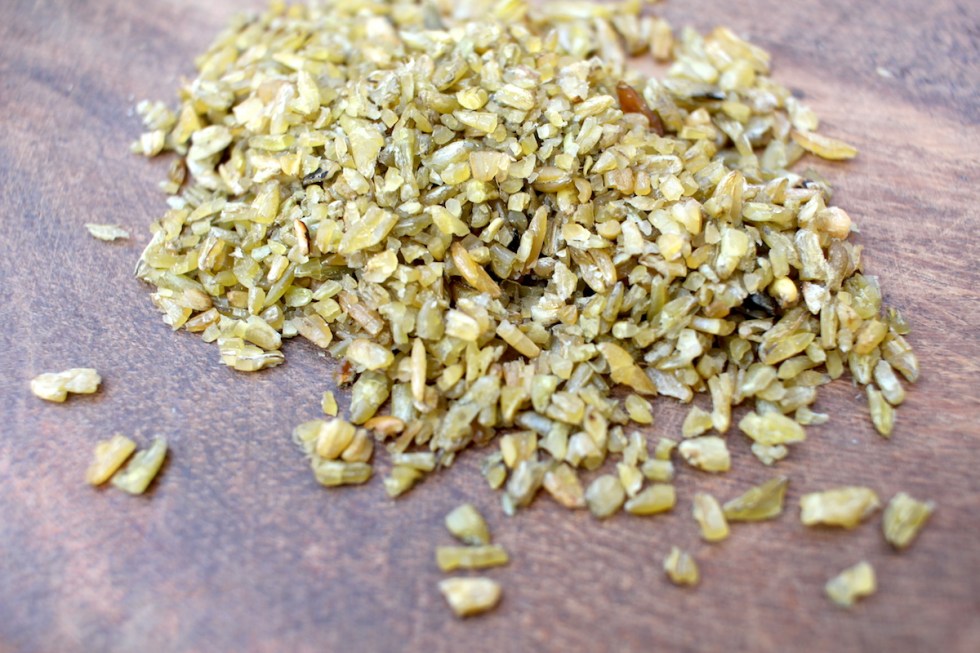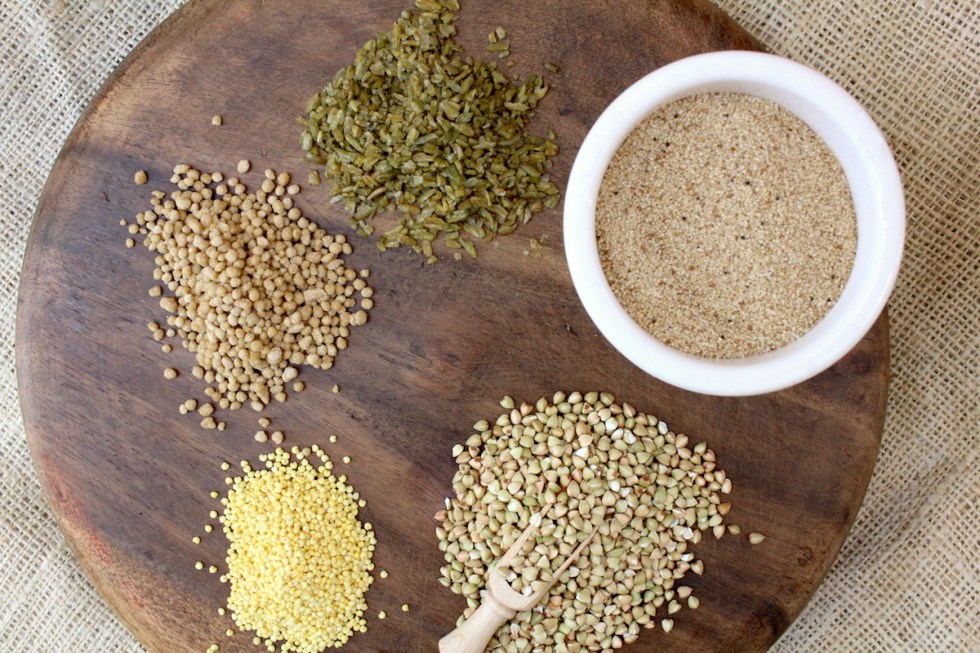Rice, pasta, cous cous and quinoa have held a place in my cupboard for a long time. All of these grains and staple sides are stored in a huge steel Budweiser bucket to contain the chaos. When I need something I bring the bucket down on to the worktop and dig through for whatever takes my fancy. Last weekend, during my ‘dig’ I found that we have five bags of quinoa on the go. FIVE. We have stock control issues.
This post is not about quinoa though, or any other aforementioned grains. Today I’m talking about five healthy grains that you perhaps haven’t tried yet, but really should. Freekeh, millet, maftoul, buckwheat and teff.
Can I first take a moment to mention the beautiful reclaimed chapatti board that I’m using in this photo? It’s from The Other Duckling who have lots of unique home and kitchenware. I love the texture in the wood and I’m sure you’ll be seeing it more in photos. It’s nice to mix up the backgrounds a bit as I’m sure you’re more than familiar with my usual props. If you’re a fellow food blogger, their website is a hive food photography props.
So the plan is that I give you an idea of what each of them are, cooking directions and a few recipe suggestions. Your side of the bargain is that you pledge to give one or two a try, maybe widen your meal planning horizons but at the very least, leave knowing that there’s more out there than rice and cous cous. So, let’s begin.
Freekeh
I have a lot of love for this smokey, nutty pile of cracked green wheat. Of the five grains included in this post, freekeh is the one I’d happily sit and eat bowls full, with no other ingredient involved.
The story goes that freekeh was discovered entirely by accident. Over 2,000 years ago, a field of wheat, not yet ready to harvest was caught in a fire. The farmer rubbed the burnt chaff away to reveal the young grain that had been too moist to burn. His crop was saved. So today we have freekeh, literally translating to ‘the rubbed one’.
 The process since has been to harvest the wheat whilst it’s soft then heap it up and leave for the sun to dry it out. Once dry, the wheat is set on fire, burning away the straw and chaff and leaving behind what will become freekeh once cracked. This ancient technique gives a robust, full bodied, smoky result that brings flavour to dishes that other grains can’t.
The process since has been to harvest the wheat whilst it’s soft then heap it up and leave for the sun to dry it out. Once dry, the wheat is set on fire, burning away the straw and chaff and leaving behind what will become freekeh once cracked. This ancient technique gives a robust, full bodied, smoky result that brings flavour to dishes that other grains can’t.
Cook: Rinse thoroughly then simmer 1 cup freekeh in 2 cups water for 30 minutes,
Recipes: Freekeh Stuffed Peppers | Freekeh Pilaf | Kale & Freekeh Soup | Roasted Sweet Potato & Freekeh Stew | Freekeh Breakfast Bowl
Millet
Millet is a staple grain for more than a third of the world’s population, and yet until last year, I’d never heard of it. It’s been farmed in East Asia for 10,000 years and is a vital protein source in dry, hot, arid environments. Somehow millet will grow happily where most other things wouldn’t.
Naturally a little sweet, like corn, its size and shape make it easy to use in place of cous cous in a salad or side by following the cooking instructions below. You can also add extra water whilst cooking and stir often for the last 5 minutes for a result similar to polenta.
 Cook: one part millet to two parts water. Simmer for 30minutes.
Cook: one part millet to two parts water. Simmer for 30minutes.
Recipes: Stir Fried Millet | Millet Burgers |Millet Porridge | Millet Falafel
Maftoul
Made from bulgar and whole wheat flour, maftoul is a traditional Palestinian staple. It’s often compared to cous cous and whilst I completely see the blatant similarities, maftoul is far superior in my opinion. It has a more substantial flavour than cous cous, is almost impossible to overcook and its rough surface gives a much better texture. That rustic outer is great for giving dressings something to cling to which is why I love using it in tabouli.
 Cook: 1 part maftoul to two parts water or stock. Simmer in a pan with a lid on for around 10 minutes by which time the liquid should be fully absorbed.
Cook: 1 part maftoul to two parts water or stock. Simmer in a pan with a lid on for around 10 minutes by which time the liquid should be fully absorbed.
Recipes: Lamb & Maftoul | Tabbouleh |Tomato Maftoul Salad |
Buckwheat
These tiny little pyramids are packed with protein and even if you don’t recognise them, you’ve probably eaten buckwheat at some point without realising. It’s the key ingredient in soba noodles, galettes and blinis.
Despite the name, buckwheat is not a member of the wheat family and so is suitable for those with Celiac disease or following a gluten free diet. Once cooked, the individual grains are harder to distinguish and they cling together, making it the ideal candidate for risotto.
 Cook: one part buckwheat to two parts water. Simmer for 15 minutes then leave to stand off the heat for 5 minutes.
Cook: one part buckwheat to two parts water. Simmer for 15 minutes then leave to stand off the heat for 5 minutes.
Recipes: Buckwheat, beetroot & feta salad | Buckwheat Parfait | Buckwheat Risotto | Buckwheat Granola |
Teff
Teff is a malty Ethiopian grain much loved by celeb clean eater Gwyneth Paltrow. It’s nutrient dense and offers a surprising amount of calcium for a grain. It works well in both sweet and savoury dishes, taking on the flavour of whatever is put alongside it.
Cook: 1 cup of teff to three cups water or stock. Simmer for 15 minutes then leave to rest for 10 minutes.
Recipes: Banana, Almond & Teff porridge | White Bean Chilli with Teff | Teff Burgers | Chia Teff Salad | Creamy Gorgonzola Teff & Herb Roasted Tomatoes


Sandra A says
Very informative! I think i’ll be trying maftoul in the near future! Thanks
http://sandrasayswhynot.blogspot.co.uk/
Emily says
Love this style of post, so informative. We’ve been planning a cheese style one for a while. We’d love to know what you think of our new blog.
http://www.wearefunnycooking.com
Emily & Rob